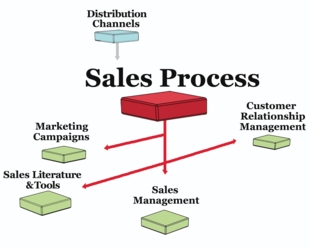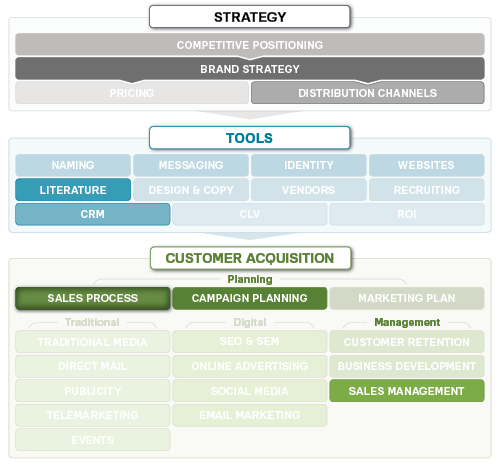Marketing Guides
Strategic Planning
Sales Process Management
How do prospects decide to purchase your product or service? Does a single decision maker find a product or service and buy on the spot, or does s/he go through many steps and approvals first? Perhaps there are multiple people or departments involved in the decision, each with their own needs?
Your sales process management determines the steps you follow as you guide prospects from initial contact to purchase. They’re far more common in B2B than in B2C, but it’s possible for many for high-ticket B2C items (such as real estate or autos) to have a distinct sales process.
Note: You can access guided, interactive templates for creating your sales process flowcharts in our marketing planning and management app. Try it for free!
Your sales process begins when you first identify a new prospect or the prospect engages with you:
| STEP 1 | STEP 2 | STEP 3 | STEP 4 | STEP 5 |
|---|---|---|---|---|
| A prospect responds to a campaign and requests information. | A sales rep calls the prospect to explain your product. | An in-person meeting and product demo takes place. | Your team submits a proposal to the prospect. | The prospect signs an agreement and makes first payment. |
An effective sales process management flowchart explains:
- Each distinct step a prospect takes
- Knowledge the prospect needs to move to the next step
- Literature and tools you provide to help the prospect move forward faster
- The length of time a prospect needs at each step
- Conversion rates: the percentage of prospects who move from one step to the next
With this documented sales process, you have a powerful tool that enables you to:
- Sell more efficiently
- Generate more accurate sales and revenue reports
- Estimate the revenue and return on investment (ROI) of your marketing campaigns
- See which stages take the most time and find new ways to move prospects forward
- Create better sales tools and literature
- Improve your campaigns
- Minimize the amount of time your reps spend on estimates and forecasts
Which of these scenarios best describes your sales process management?
| Best Case | Neutral Case | Worst Case |
|---|---|---|
| You have a well-designed sales process that measures the number of prospects you have at each stage, how long they stay in each stage, and the revenue that your entire pipeline represents.
You deliver the right amount of information prospects need at each step, which helps them make decisions quickly and move to the next stage. You use your process to create more successful marketing campaigns because you can predict how many leads will become customers and what those leads will be worth to your company. |
You may or may not have a defined sales process.
You generally follow the same steps to create a customer, but there’s a big variance in the amount of time it takes to close each one. Even your strongest reps have trouble closing certain types of prospects. Your forecasts are probably all manual and generally accurate, but you wish you had a reliable snapshot to show exactly how many accounts are at a certain stage and what you need to do to close. |
You don’t use any sales process management, or you use one that doesn’t match how prospects want to buy.
You deliver all of the information about your product but then seem to lose control of the prospect. Some prospects end up buying, but you don’t know why the others don’t. It’s a constant battle to figure out how many real prospects you have and what they’re worth. Your sales team often spends valuable time creating manual reports instead of selling, which further hurts your marketing and sales performance. |
Not Sure Where to Start with Your Sales Process Management?
Access detailed step-by-step plans in our new marketing website.
It’s free to use

Sales Process Managment Concepts & Steps
Before you begin
If you have multiple distribution channels, you might find that you have a different sales process for each. And, you could have a different process for each offering you provide within an existing channel, so it’s valuable to document the buying steps that your market prefers to take for each offering within each channel combination.
Your sales processes are also influenced by your positioning, brand strategy and pricing. Your brand personality should be evident at each step in the process. For example, if you’re delivering a luxury experience, don’t use pushy and aggressive sales tactics, and don’t use price discounts to convert prospects to customers.
Determine how your prospects buy
List the steps you think prospects logically take from the time they recognize a problem to the time they purchase a solution. Talk with customers or ask your sales reps for more insight. Figure out what steps they take, what they need to know at each step and how you can deliver that information most effectively.
Create your sales process
For each step your prospects need to take, list:
- What the prospect needs to learn
- Sales tools and literature you can provide to help the prospect move forward
- The length of time a prospect needs at that step
- The percentage of prospects who move from each step to the next (your “conversion rate”)
Project campaign results and revenue
When you have a sales process with conversion rates, you can quickly generate solid pipeline and revenue reports. For example, if you have 50 prospects at the presentation stage, your process may show that 20% will become customers. That means those 50 prospects should deliver 10 new customers. Your process will also tell you when that should happen and how much revenue those prospect represent.
You can use a similar calculation to project results from new marketing campaigns. For example, if a campaign should produce 100 qualified leads, you can estimate the number of meetings, presentations, and new customers the campaign will generate.
Improve your process to maximize revenue
When you have a defined process, it’s easier to test ideas for improving results. For example, you can
- Identify spots where prospects get “stuck” in the process and try new materials or messages to help them move forward
- Measure how well different reps convert at each step and help those that aren’t doing as well
- See how leads from different marketing campaigns convert and improve your campaigns
- Create campaigns to “recycle” leads that fall out of the process at various spots
After Documenting Your Sales Process Management Procedures
After you’ve documented your process, develop the sales tools and literature you’ll need to guide your prospects through each step. Add your process to your customer relationship management (CRM) software so that each account is assigned to a stage at all times. Then you can run reports and measure your progress and improve your sales management.
SALES PROCESS MANAGEMENT TEMPLATES / MARKETING PLANS / PROJECT MANAGEMENT
EVERYTHING YOU NEED FOR YOUR SALES PROCESS MANAGEMENT PROJECT
